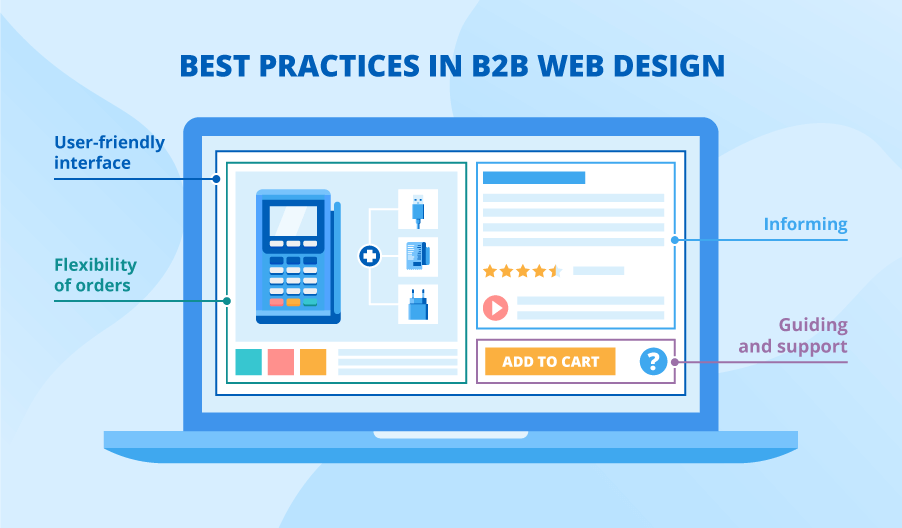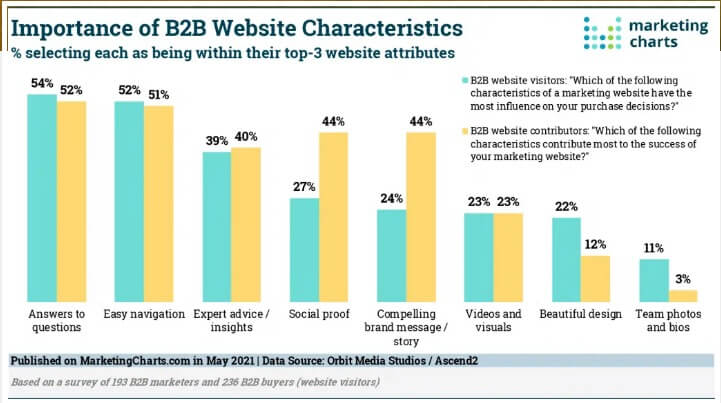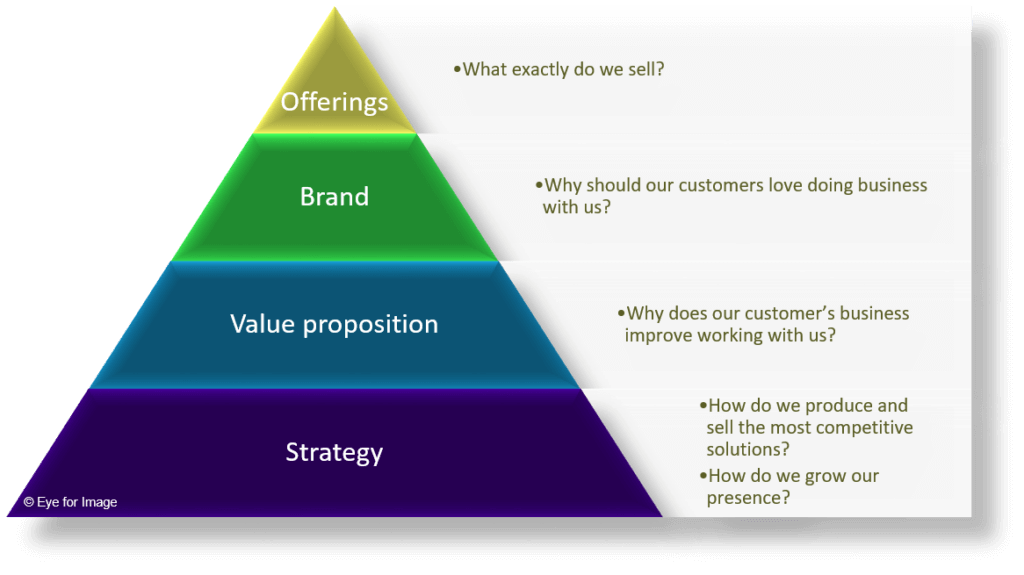9 Keys to a Great Website Strategy

Seven out of ten B2B buyers use the seller’s website as a resource when they’re researching a purchase. Websites can look pretty, load fast, and be full of exciting content, but none of these things are going to drive conversions for B2B sellers unless they’re part of a coherent B2B website strategy.
A strategy ensures that your website isn’t just a pleasant diversion for buyers on the journey toward purchasing your product or service. Your strategy determines how and when you’re going to deliver content to buyers once you’ve got their attention.
Without a strategy, buyers are likely to encounter content that isn’t relevant — and that’s when they start losing interest, and your chance to convert them starts to slip away. The goal, of course, is to direct them toward specific conversion actions and move them deeper into your sales funnel.
Your website will be a critical destination in most B2B buyer journeys, so you want to have your strategy planned out to the last detail. We’ll share nine keys for crafting an effective B2B website strategy that will help drive sales in this post.
What is a B2B website strategy?
A B2B website strategy is a documented plan for developing your website to actively support your marketing and sales objectives. Your strategy has to account for changing trends in technology, ecommerce, and user behavior, but ultimately it has to be based on a solid understanding of your brand identity and your target audience.
Website development was one of the top items on B2B marketing budgets in 2020, but development without a strategy creates slick websites that buyers won’t stick with. It doesn’t make sense to create fancy digital brochures or self-serve content libraries when you can deliver customized content based on what you know about a lead. Instead, you could be giving them the exact information they need to take another step closer to their final purchasing decision.
When putting together the strategy for your B2B website, here are the nine keys you need to incorporate to make it great.
9 Keys to a Great Website Strategy
1. Take a Closer Look at Your Brand
Sometimes the launch of a new website strategy synergizes well with a rebrand, but pairing the two isn’t always necessary. From a strategic perspective, it’s essential that your branding is appealing to your target audience and aligns with your goals.
Just don’t let high-concept branding concepts trip you up. The customer experience should always come first, which means putting your audience’s needs at the top of your priority list. When branding gets in the way of user-centric design, the branding needs to evolve.
2. Create a Great UX and Mobile Experience
You can’t create a great website strategy without a great UX, and these days, that also means optimizing for mobile. As many as seven in ten B2B searches happen on smartphones, so it’s no longer safe to assume that browsing websites on a PC is the default.

Test your website to ensure that it loads and displays perfectly on the devices your customers actually use. Keep in mind that they’ll be reading your content copy on small handheld screens in-between countless other activities. Respect their time by keeping things concise, relevant, and simple to navigate.
3. What are your users’ intentions?
Depending on where they’re at in their purchasing journey, buyers will have different intentions when they visit your website. These might be:
- Navigational: The user is trying to locate your site and establish basic facts about your company.
- Informational: The user is looking for general information about your industry, products, or services.
- Commercial: The user is trying to find information to help them decide what to purchase.
- Transactional: The user is ready to make a purchase.
Your strategy should include different landing pages, content pathways, and lead capture forms for each possible intention.

4. Get Clear On Your Messaging
Your branding might determine what kind of story you’re telling about your company. But it’s up to your messaging to deliver content that fits your brand and conveys the right information to the right audience at just the right time.
Whatever your strategic vision may be, your content has to back it up and give the customers what they’re looking for. The better you understand them, the more you can tailor your content to meet their needs.
5. Create a Content Marketing Strategy
If there’s one common denominator in what B2B buyers are looking for when researching an important purchase, it’s value. Buyers want content that answers their questions, expands their knowledge, and helps them feel more confident in their decision-making process.
The questions your buyers have, and the knowledge they need to move forward, will change as their buyer’s journey progresses. To execute a strong content marketing strategy, you need to map where they’re at in their journey and make sure they’re connecting with the content that will bring them the most value at that moment.
6. Don’t Forget the SEO
It’s nice to focus on the leads who have already found their way to your website, but maintaining a steady flow of web traffic is still critical to the success of your strategy. SEO optimization is a required element of your website to help create organic traffic.
Your website strategy should utilize audience research, keyword research, and competitor research to inform on-page SEO enhancements that attract buyers to the appropriate landing pages.
7. Make It Easy to Do Business with You
When a potential customer visits your website, you don’t want them to wonder how to contact you if they have a question or are ready to take the next step toward purchasing. As simple as it is, the one thing B2B buyers most want to see on a vendor website is thorough contact information.
Making it easy to do business also includes presenting a clear value proposition. It shouldn’t be a puzzle for buyers to determine what sets you apart from your competitors. Always include clear and visible Calls to Action on all content pages. Extend appealing special offers to your visitors, and get creative about positioning contact forms in unexpected (but welcome) places.

8. Track and Personalize the Buyer’s Journey
Customer personas and behavioral statistics have some practical predictive abilities. Still, the only way to know what’s going on in a particular buyer’s journey is to track the buyer’s activity across your website, then analyze the data to map out exactly where they are and what they’re looking for.
In this case, you need the right tools to get the job done, such as Trendemon. Once you have tracking and analytics software set up to deliver real-time insights, you can deepen engagement with the buyer by delivering personalized content.
9. Get the Buyer to Take Action
The goal of a website strategy isn’t to get a buyer to keep visiting your website – it’s to convince them to make a purchase. You have to keep nudging the buyer closer to the next step in their purchasing process, and you can do that by inviting them to take certain actions.
Product comparison charts can help buyers rule out some of your competitors. Training and demonstration videos can give buyers a feel for your product and advance knowledge about implementing it. Provide visitors with multiple strategically-placed conversion points, and always offer an easy off-ramp to a live meeting or demonstration if they’re ready to take that step.
Unlock Conversions with a Great Website Strategy
When B2B buyers visit your website, they’re looking for something. If you can anticipate what it is and provide it to them, you have a good opportunity to convert them into a loyal customer. A great website strategy is all about making buyers feel like your website is always the best place to go when they need answers about the solution they’re considering.
The thing about strategy is that it’s only as strong as the intelligence that’s shaping it, so it’s crucial to have reliable insights driving your decisions. By using a powerful customer journey mapping solution, you can turn every buyer’s website visit into a treasure trove of data – illuminating your website strategy and keeping your sales pipeline full.